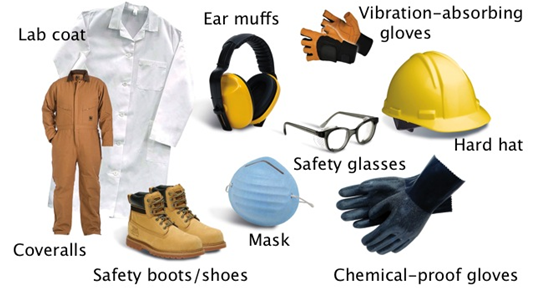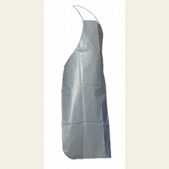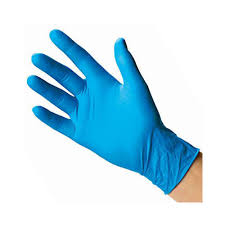Table of Contents
CARE IN LABORATORIES
Laboratories are delicate places. Carelessness can cause serious accidents.
The two most important words to remember when working in a lab are “Be CAUTIOUS and LABORATORY WORK DONE WITHOUT ENOUGH CARE TURNS TO BE UNWORTHY”. It is important to note that:
– Familiarity with materials and equipment being used is important
– Safety equipment like fire extinguishers and first aid kits must be placed where they can be easily located and picked for use in case of accidents
– Ignorance and negligence are two of the major causes of accidents in the laboratory
– Follow the instructions given to you and do all your experiments with utmost precautions
RULES OF DISCIPLINE IN THE LABORATORY
- Do not enter the laboratory unless you are instructed to do so;
- Never run or chase each other in the laboratory;
- Do not leave any object in the passage ways or the floor
- Never taste any of the chemicals found in the laboratory
- Never eat or drink anything in the laboratory
- Do not leave the table or the apparatus untidy. Always clean them and return the apparatus to their proper places;
- Do not hesitate to seek advice where you are not sure;
- Do not fail to report any accidents, however small, that occur
- Do not perform any lab work until you have been briefed.
- Do not enter instructor stations or the Stockroom unless asked to do so by the staff.
EXPERIMENTS INVOLVING HEAT
Three main sources of heat that may be available in the laboratory are: Bunsen burner, spirit lamps and electric hot plates.
They present dangers such as fires explosion, burns and scalds. To avoid the dangers, the techniques below are to be followed:
- If the substance to be heated in a test is a solid, slant the test tube in such a way that the substance is spread out and does not block the test tube. In addition to this, a Pyrex type of test tube should be preferred when heating
- When heating a liquid in a test tube:
- The test tube must not be more than a quarter full
- Use a wide boiling tube and keep shaking it gently all the time
- Use a gentle flame to avoid rapid boiling
FIGHTING THE FIRE
In case of fire in the lab, observe the following:
Fight a fire ONLY if ALL of the following are TRUE
- Everyone has left, or is leaving the lab.
- Public Safety has been called (911).
- The fire is very small and confined. (If the fire is in a beaker or a wastebasket, try to smother it by covering the container. Often, this works quite well and does not require the use of a Fire Extinguisher.)
- You have a way out and you can fight the fire with your back to the Exit.
- The extinguisher is rated for the class of fire you are fighting.
- You can stay close to the floor to avoid breathing too much of the smoke.
- You have had training and you feel confident in the use of the extinguisher, or no other escape alternative is available to you.
It is usually best to have the teacher or lab assistant operate a fire extinguisher if one is needed at all. Much damage can be done by the improper use of a fire extinguisher.
When you are ready to use the extinguisher, you should consider the following:
The key word to operating a fire extinguisher is PASS. This acronym is a good way to remember exactly what to do:
- PULL the pin. Point the nozzle away from you and release the locking mechanism.
- AIM low. Hold the extinguisher upright. Aim at the base of the flame. You should be 2 to 3 metres away. If you are too close, you will hit the fire with enough force to scatter it. If you are too far away, you may not reach the fire with enough extinguishing material.
- SQUEEZE the trigger. Be prepared. The extinguishing agent may come out with considerable force and noise. Most portable extinguishers will last for only 15 to 30 seconds. That is the actual “fighting time” you have. You can prolong the effective fighting time if you use short bursts. If aimed well, they can be very effective.
- SWEEP side-to-side. Drive the fire back. As you extinguish the fire closest to you, move forward, but continue the sweeping motion.
Once the fire is out, you should have your teacher and the lab assistant check on the area. They will assume the responsibility of following up the incident with the appropriate authorities i.e. if necessary. This will include making certain that all persons are out of the area, insuring that another fire extinguisher is nearby in the event of a recurrence of the fire, and making arrangements to replenish the spent extinguisher. Remember you will probably NOT need to use a fire extinguisher at all in your physics laboratory.
Abandon the Fight if ANY of the following are TRUE
- The fire has started to spread.
- Your escape route may be blocked.
- You have any trouble operating the extinguisher.
As you leave the lab, close the door to prevent spread of the fire and call 911 to be sure help is on the way. Then leave the building and wait in the designated area for help to arrive. (Remember that everyone must be accounted for at the meeting place BEFORE leaving that area. Anyone not found at the meeting area will be presumed trapped inside and someone will attempt a rescue).
CHEMICAL EXPOSURES
The following procedures should be followed in the event of chemical exposure. In all cases, the incident should be reported to the teacher, regardless of severity.
Chemicals on Skin or Clothing
- Immediately flush with water for no less than 15 minutes.
- While rinsing, quickly remove all contaminated clothing or jewellery. Seconds count.
- Discard contaminated clothing or launder them separately from other clothing.
- Do not use solvents to wash skin. They remove the natural protective oils from the skin for they can cause irritation and inflammation.
Chemicals in Eyes
- Immediately flush eye(s) with water for at least fifteen minutes.
- The eyes must be forcibly held open to wash, and the eyeballs must be rotated so all surface area is rinsed.
- The use of an eye wash fountain is desirable so hands are free to hold the eyes open.
- If eyewash is not available, pour water on the eye, rinsing from the nose outward to avoid contamination of the unaffected eye.
- Seek medical attention regardless of the severity or apparent lack of severity.
Chemical Inhalation
- Close containers, open windows or otherwise increase ventilation, and move to fresh air.
- If symptoms, such as headaches, nose or throat irritation, dizziness, or drowsiness persist, seek medical attention immediately.
Accidental Ingestion of Chemicals
- Immediately seek medical assistance.
- Unless directed to do so by a health care provider, you must not induce vomiting to the victim.
Controlling Chemical Exposure, in general involves the use of personal protective equipment
Personal protective equipment (PPE) is a special gear used to protect the one wearing it from specific hazards of a hazardous substance. It is a last resort protection system, to be used when substitution or engineering controls are not feasible. PPE does not reduce or eliminate the hazard but protects only the one wearing it and does not protect anyone else.
EYE PROTECTION
In order to protect your eyes against chemical exposure, the safety Glasses and/ or face shield can be used depending on the exposure level.
(a) Safety glasses
Safely glasses look very much like normal glasses buy have lenses that are impact resistant and frames that are far stronger than standard street wear glasses. Safety glasses must have side shields and should be worn whenever there is the possibility of objects striking the eye, such as particles, glass, or metal shards. Many potential eye injuries can be avoided by wearing safety glasses.
(b) Face Shields
The face shields, are in order when working with large volumes of hazardous Materials, either for protection from splash to the face or flying particles. Face shields must be used in conjunction with safety glasses or goggles.
PROTECTIVE CLOTHING & FOOTWEAR
When the possibility of chemical contamination exists, protective clothing that resists physical and chemical hazards should be worn over street clothes. Lab coats are appropriate for minor chemical splashes and solids contamination, while plastic or rubber aprons are best for protection from corrosive or irritating liquids.
(a) Aprons – Rubber or Plastic
Chemical aprons can provide additional secondary protection. Some operations in the laboratory, like washing glassware, require the handling of relatively large quantities of corrosive liquids in open containers. To protect clothing in such operations, plastic or rubber aprons may be supplied. A high-necked, calf- or ankle-length, rubberised laboratory apron or a long-sleeved, calf- or ankle-length, chemical- and fire-resistant laboratory coat should be worn any time laboratory manipulation or experimentation is being conducted. Always wear long-sleeved and long-legged clothing; do not wear short-sleeved shirts, short trousers, or short skirts.
(b) Lab coats
Loose clothing (such as overlarge lab coats or ties), skimpy clothing (such as shorts), torn clothing and unrestrained hair may pose a hazard in the laboratory. Always wear the lab coat when working in the laboratory.

(c) Protective shoes
Closed-toed shoes should be worn at all times in buildings where chemicals are stored or used. Perforated shoes, sandals or cloth sneakers should not be worn in laboratories or where mechanical work is conducted. Such shoes offer no barrier between the laboratory worker and chemicals or broken glass.
Chemical resistant overshoes or boots may be used to avoid possible exposure to corrosive chemical or large quantities of solvents or water that might penetrate normal footwear (e.g., during spill clean-up). Leather shoes tend to absorb chemicals and may have to be discarded if contaminated with a hazardous material.
(d) Protective gloves
Protective gloves should be worn when handling hazardous materials, chemicals of unknown toxicity, corrosive materials, rough or sharp-edged objects, and very hot or very cold materials. When handling chemicals in a laboratory, disposable latex, vinyl or nitrile examination gloves are usually appropriate for most circumstances. These ‘gloves will offer protection from incidental splashes or contact.
When working with chemicals with high acute toxicity, working with corrosives in high concentrations, handling chemicals for extended periods of time or immersing all or part of a hand into a chemical, the appropriate glove material should be selected, based on chemical compatibility.
FIRST AID IN THE LABORATORY
First aid is the provision of immediate care to a victim with an injury or illness, usually conducted by a lay person, and performed within a limited skill range.
The first aid assistance should be applied until the injury or illness is satisfactorily dealt with (such as in the case of small cuts, minor bruises, and blisters) or until the next level of care, such as an ambulance or when a doctor arrives.
The key guiding principles and purpose of first aid is often given in the mnemonic “3 Ps”. Each “P” stand for:
- Prevent further injury
- Preserve life
- Promote recovery
First Aid Kits
First aid kits must be available in the laboratory and must, be kept in sanitary condition; be limited to simple household-supplies such as in band aids and sterile gauze pads; and include the such personal protective equipment like a pair of laboratory gloves.
There are two main classes of first aid kits according to the International Safety Equipment Association (ISEA) classification: Class A kits are for small offices with few employees. Class B kits are for more complex or higher-risk environments which could be applied to the tasks being performed or that has to service more people like in industrial facilities or warehouses.
Simple first aid kit components
The following can make up a simple first aid kit:
- A leaflet giving general advice on first aid;
- 20 individually wrapped sterile adhesive dressings (assorted sizes);
- Two sterile eye pads;
- Four individually wrapped triangular bandages (preferably sterile);
- Six safety pins;
- Six medium sized (approximately 12cm x 12cm) individually wrapped sterile undedicated wound dressings;
- Two large (approximately 18cm x 18cm) sterile individually wrapped undedicated wound dressings;
- One pair of disposable gloves.
- Equivalent or additional items are acceptable.








